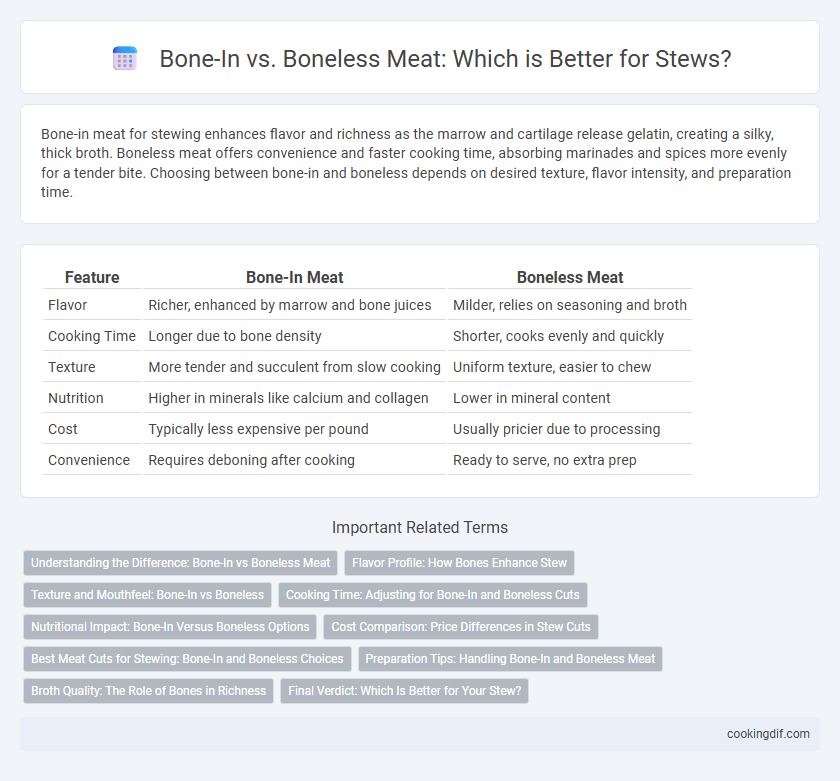Bone-in meat for stewing enhances flavor and richness as the marrow and cartilage release gelatin, creating a silky, thick broth. Boneless meat offers convenience and faster cooking time, absorbing marinades and spices more evenly for a tender bite. Choosing between bone-in and boneless depends on desired texture, flavor intensity, and preparation time.
Table of Comparison
| Feature | Bone-In Meat | Boneless Meat |
|---|---|---|
| Flavor | Richer, enhanced by marrow and bone juices | Milder, relies on seasoning and broth |
| Cooking Time | Longer due to bone density | Shorter, cooks evenly and quickly |
| Texture | More tender and succulent from slow cooking | Uniform texture, easier to chew |
| Nutrition | Higher in minerals like calcium and collagen | Lower in mineral content |
| Cost | Typically less expensive per pound | Usually pricier due to processing |
| Convenience | Requires deboning after cooking | Ready to serve, no extra prep |
Understanding the Difference: Bone-In vs Boneless Meat
Bone-in meat for stewing enhances flavor and richness as the marrow and connective tissues break down during cooking, infusing the stew with a deeper, more complex taste. Boneless meat offers ease of preparation and quicker cooking times, making it ideal for faster meals but may lack the same depth of flavor. Understanding these differences helps in selecting the best option based on desired stew texture, taste intensity, and cooking duration.
Flavor Profile: How Bones Enhance Stew
Bones in stew release collagen and marrow during slow cooking, enriching the broth with a deeper, richer flavor and a silky texture. The marrow imparts a subtle umami complexity and enhances overall mouthfeel, making the stew more satisfying and savory. Boneless meat stews tend to lack this depth, often requiring extra seasoning to compensate for the absence of natural gelatin and flavors from bones.
Texture and Mouthfeel: Bone-In vs Boneless
Bone-in meat enhances stew texture by releasing collagen and gelatin during cooking, resulting in a richer, silkier mouthfeel. Boneless cuts provide a more uniform tenderness but may lack the deeper, savory complexity that bones impart. Choosing bone-in pieces elevates the stew's body and flavor depth, creating a more satisfying eating experience.
Cooking Time: Adjusting for Bone-In and Boneless Cuts
Bone-in meat requires longer cooking times in stewing to allow heat to penetrate the bone and fully tenderize the surrounding meat, enhancing flavor depth through marrow infusion. Boneless cuts cook faster due to direct heat exposure and lack of bone, often reducing stewing times by 15-30%, ideal for quick recipes. Adjusting cooking time ensures optimal tenderness and flavor extraction depending on whether the meat is bone-in or boneless.
Nutritional Impact: Bone-In Versus Boneless Options
Bone-in meat for stewing retains marrow and minerals such as calcium and phosphorus, enhancing the dish's nutritional profile with additional collagen and gelatin that support joint health. Boneless cuts, while easier to prepare and leaner, often lack these nutrients because they do not contain bone-derived elements released during cooking. Choosing bone-in meat boosts nutrient density, providing richer flavor along with beneficial micronutrients compared to boneless options.
Cost Comparison: Price Differences in Stew Cuts
Bone-in meat for stewing generally costs less per pound than boneless cuts due to the presence of the bone, which adds weight without extra edible meat. Boneless stew cuts demand higher prices because they require additional butchering and yield more meat per pound. Choosing bone-in options can reduce overall stew preparation costs while providing rich flavor from marrow and collagen during cooking.
Best Meat Cuts for Stewing: Bone-In and Boneless Choices
Bone-in cuts like beef chuck and pork shoulder offer rich flavor and tenderness during slow stewing as the marrow infuses the broth. Boneless cuts such as sirloin or round provide ease of preparation and quicker cooking times while still delivering a tender texture when properly braised. Choosing between bone-in and boneless depends on desired flavor intensity and convenience, with bone-in cuts often preferred for deeper, more complex stews.
Preparation Tips: Handling Bone-In and Boneless Meat
When preparing stew, handling bone-in meat requires careful trimming of excess fat and thorough cleaning around the bones to enhance flavor and ensure even cooking. Boneless meat should be cut into uniform pieces to promote consistent tenderness and faster cooking times. Proper seasoning and allowing meat to rest before cooking help retain juices and develop richer stewing flavors.
Broth Quality: The Role of Bones in Richness
Bone-in meat significantly enhances stew broth quality by releasing gelatin, collagen, and minerals during slow cooking, resulting in a richer, more flavorful base. Boneless cuts lack these components, often producing a thinner, less savory broth. Using bone-in pieces ensures a hearty texture and depth that elevates the overall stew experience.
Final Verdict: Which Is Better for Your Stew?
Bone-in meat enriches stew with deeper flavors and gelatin, enhancing texture and mouthfeel, while boneless cuts offer quicker cooking and easier portioning. Choosing bone-in meat is ideal for slow-cooked stews requiring rich, savory depth, whereas boneless meat suits fast-paced recipes needing tenderness without extra fat. Quality and cooking time determine the best option, with bone-in preferred for traditional hearty stews and boneless for convenience-focused dishes.
Bone-In vs Boneless Meat for Stewing Infographic

 cookingdif.com
cookingdif.com